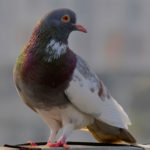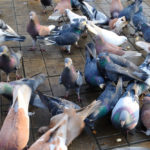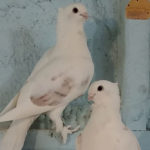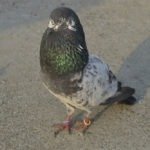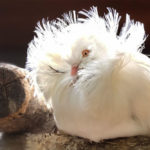In the same way there are domesticated and feral horses, pigeons generally come into two categories: domesticated and feral.
While domesticated pigeons are popular among owners and hobbyists for their quiet and docile nature, feral pigeons aren’t quite the same.
No, they’re not totally rabid birds, but there’s a lot about feral pigeons that we don’t yet know about.
Whether you love them or hate them, feral pigeons are basically everywhere in urban areas.

It’s about time we understand everything about these highly populated, quiet, and elusive birds that are often considered an invasive species.
Here is the ultimate guide to feral pigeons!
What Is A Feral Pigeon?
There’s often a misunderstanding between the terms “feral pigeon” and “wild pigeon”.
A feral pigeon is found in urban cities, often found in large groups surrounding humans who might look like they have food to spare.
Wild pigeons, however, are found in coastal areas and don’t tend to gather in large groups, nor do they live in close proximity to humans due to the smaller population.
It’s also common for feral pigeons to come under a variety of other names, including “wild rock pigeons”, “blue rock pigeons”, “rock doves” and “rock pigeons”.
Pigeons got their name from the Latin name “Columba livia”, which translates to “rock dove” and refers to blueish-gray birds.
The word “pigeon” is also said to derive from the Latin word “pipio”, translating to “young chirping bird”.
Pigeons are among some of the most common birds in the world, with around 350 types of pigeons documented and an estimation of 10-15 million in Europe alone.
What Do Feral Pigeons Look Like?
Feral pigeons vary in size and color for a variety of reasons, usually food related, but here are the general physical characteristics of a feral pigeon:
Wingspan: 25-28”
Length: 12.5-14.5”
Weight: 0.25-2.22 kg
Color: Generally blueish-gray all over the body with a hint of green and purple feathers around the neck.
Their legs are covered in a fluffy white down, and white feathers are exhibited across the back sporadically.
The edge of their wings feature black bands that are mostly visible in flight. As juveniles, their eyes are predominantly brown before they turn amber in adulthood, developing a reddish ring around the eyes.
Their beaks are black with a white line above them, and their legs are pinkish-red.
What Do Feral Pigeons Eat?
Domestic pigeons undoubtedly get the best diet compared to feral pigeons. These birds get a variety of vegetables, grains, seeds, fruits, a protein from pre-made pigeon food mixes and fresh produce.
As feral pigeons don’t have access to such foods, they have to be a bit more creative.
Feral pigeons are notorious scavengers who will eat virtually anything they find on the ground.
If you’ve ever seen a flock of pigeons in a city, you’ve probably seen them surrounding people who are dropping crumbs or pieces of food like bread and snacks.
While this isn’t exactly the healthiest source of food for the birds, it’s food nonetheless.
Feral pigeons will also be found eating worms and insects in urban parks or backyards as well as the seeds fallen from trees.
This is their only main source of protein. In terms of water, feral pigeons are also found near rivers, ponds, and fountains in cities.
As you can imagine, the diet of a feral pigeon isn’t a healthy one.
These birds are constantly exposed to poisonous substances, unhealthy foods that will get stuck in their system, and pollution in dirty water.
What Is The Lifespan Of A Feral Pigeon?
Due to their unhealthy and risky diet, predation, and exposure to negative human interaction, feral pigeons are only said to live for 3 to 6 years.
Some feral pigeons might live slightly longer if they are lucky.
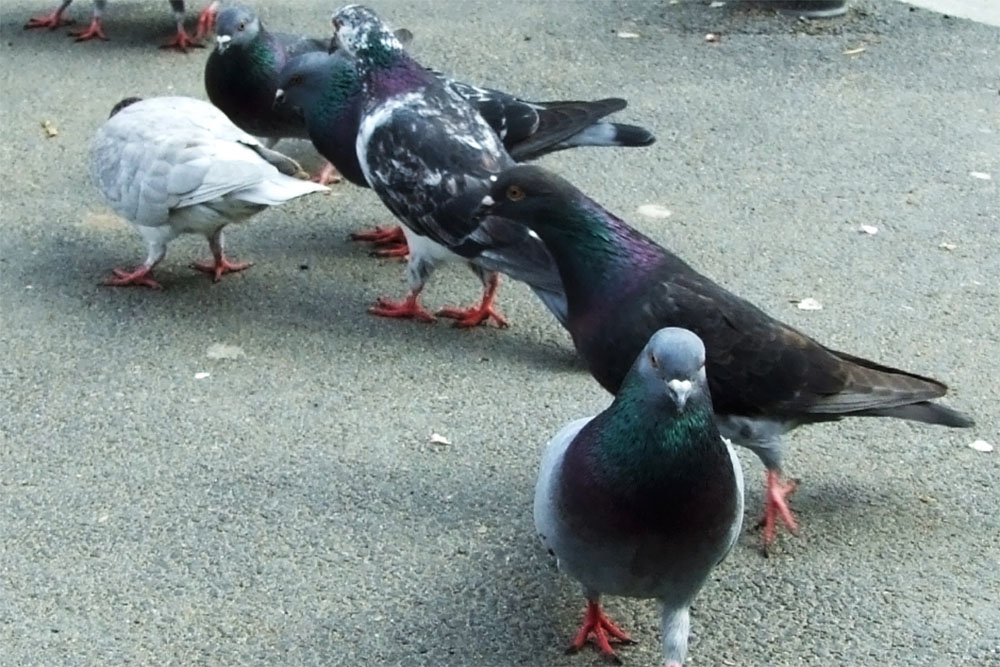
As you can expect, feral pigeons who live in highly populated cities have a shorter lifespan than those who live in areas of a lower human population.
Other factors that contribute to their short lifespan include consuming poisonous or polluted food and water, being attacked by domestic animals like dogs, and being hit by vehicles.
Domestic pigeons, however, live in a far safer environment, making their lifespan around 9 to 15 years long. In some cases, domestic pigeons can live up to 20 years old!
What Is The Reproductive Behavior Of A Feral Pigeon?
It’s common for feral pigeons to breed throughout the year, but the most common time for breeding is between spring and summer.
When they are prepared to breed, feral pigeons will build their nests out of twigs, leaves, and often trash in quieter areas such as rooftops.
Both the male and female will build the nest together, and once the courting has been successful, they will remain monogamous for life.
Everything is very balanced in a feral pigeon couple.
The mother will generally lay 2 eggs per brood, with both the mother and father sharing the incubation period and hunting for food.
In general, the father will incubate the eggs in the morning to afternoon while the mom rests, before she then takes over for the night shift.
Once hatched, the parents will share the duties of collecting food and feeding the baby pigeons (known as “squabs”) crop milk.
What Is The Life Cycle Of A Feral Pigeon?
After the squabs have been hatched, most feral baby pigeons take around 30 days to leave the nest. These birds grow pretty fast, which is why they basically look like adult pigeons by the time they fly off.
This is why it’s so rare to see squabs and juvenile pigeons!
Feral pigeons will actually reach sexual maturity at around 6-7 months old, which is when they can start immediately breeding.
In most cases, pigeons will generally wait until they are at least a year old before they reproduce.
This is because female pigeons who reproduce the moment they hit sexual maturity will often only produce 1 egg per brood, so they’ve learned to wait until they are a year old to double the amount of eggs produced.
This also gives them enough time to find a mate.
What Predators Do Feral Pigeons Have?
For feral pigeons that live in densely populated cities, humans are their biggest predator.
Whether the death or harm of a feral pigeon is caused by eating unhealthy human foods or getting hit by a car, humans are the root cause of this.
In a lot of cities, feral pigeons are seen as an invasive species, which is why humans are often so careless and destructive towards pigeons.
While feral pigeons in quieter urban areas might not have humans as their main threat, there are a bunch of other predators out there.
Peregrine falcons and other birds of prey will often feed off pigeons due to their small size and the fact they’re less skittish than other birds, making them somewhat easy to catch.
Climate change and pollution are also predators that pigeons, amongst virtually every animal on the planet, have to face.
What Are The Flight Characteristics Of Feral Pigeons?
It’s not often that you’ll see feral pigeons in flight considering how much time they spend pecking on the ground, but these birds actually have very interesting flight characteristics.
It might come as a surprise, but pigeons can easily fly up to 78 miles per hour, and can reach altitudes of 6,000 feet! One pigeon was even recorded to reach a speed of 92.5 miles per hour.
These birds are surprisingly fast and have brilliant stamina, and even though they don’t do it often, they have the ability to fly up to 700 to 800 miles a day.
Fun Facts About Feral Pigeons
- Feral pigeons are some of the world’s best navigators. They have something of an internal magnetic compass and a brilliant eye for landmarks and roads to direct them to their next destination.
- Feral pigeons are sociable birds, gathering in flocks of sizes of between 50 and 500.
- Pigeons are most famously known for sending messages to the front lines in World War 2.
How To Protect Feral Pigeons
Despite common belief, feral pigeons don’t carry diseases, which means they aren’t an invasive species or pest at all. The best thing to do with feral pigeons is to simply leave them alone!
If numbers get too high, it’s best to seek the help of a local animal society or rescue shelter rather than find ways to kill the birds, because this can negatively impact the immediate ecosystem.

